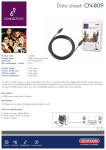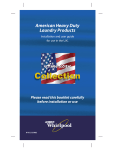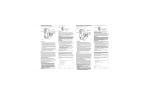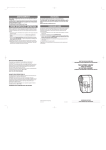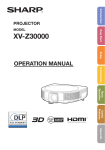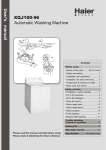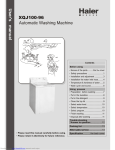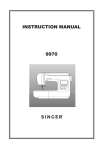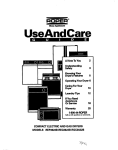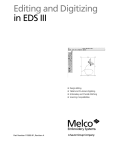Download Collection
Transcript
American Heavy Duty Laundry Products Installation and user guide for use in the U.K. American Collection Please read this booklet carefully before installation or use W10131548A Thank you for buying a Whirlpool American Heavy duty washer or dryer. We appreciate that this is an important purchase for you and we want to be sure that you get the best performance possible. There are a few differences with these products when compared with conventional European models and it is important that you are aware of them when preparing for the installation. Please pay particular attention to the water pressure requirements and the type of detergent used. Washers • ELECTRICAL CONNECTION The power consumption on the washers is very low, an approximate max of 3 amps, and you can connect to a standard 13 amp supply. • WATER CONNECTIONS: Hot and cold fill. You must connect to both hot and cold water supplies. Connection is to a ¾ inch BSP (standard UK thread) tap or a stopcock to shut off the water supply, with a minimum water pressure of 15 PSI*. This is no different from a standard washer. It is important that you have a good supply of hot water, as the wash temperature is dependent on the temperature of the incoming water.** NOTES: *If either the hot or cold water pressure is low, the fill time will be extended, and some of the advantages of the very short wash cycles will be lost. Because the cycle includes a spray rinse, if the cold water pressure is low, there is no “spray” effect and the rinsing is not as effective. **Wash Temperature; if the hot water pressure is very low and the cold water pressure is high, the “mixing” could result in a low wash temperature. Low water pressure is not wide spread, but if it does affect you, it can be overcome by fitting a “booster pump”. Operating the washer with low water pressures will result in poor wash and rinse performance. * 15 PSI means a water tank needs to be approximately 30 feet above the machine. • DRAIN CONNECTIONS: This is a large capacity washer and requires a slightly larger drain hose than normal. On standard washers the drain hose is normally placed into a 1-1/2 inch stand pipe. On the Heavy Duty washer, you will need a 2 inch stand pipe (or you could place it directly into a suitable sink if preferred). Dryers • ELECTRICAL CONNECTION The heater on the electric model is larger than a standard European model, and the total power required to operate the dryer is more than a normal 13 amp socket can provide. It is therefore necessary to connect the power cable directly into a suitable electrical supply that is rated at 30 amps or above, i.e. a spare cooker box. • VENTING The dryer should be vented to avoid excessive build up of condensation in the room. The venting outlet on the dryer is a standard 100mm (4 inch) and does not require any special adapters to connect it to the dryer. Use metal ducting or a flexible metal hose. A standard length metal hose is provided with most models, longer lengths or kits with an elbow are available from Whirlpool Service, telephone: 0870 600 8989, or from most DIY stores or builders merchants. If in doubt about any of the installation requirements, please contact our technical advice department at 020 8649 5228. Choosing the correct detergent To obtain excellent wash results, it is advisable to use a product which is specially designed for top loading washing machines rather than a product which is used in front loading automatic washing machines. How to get the best results Sort your clothes according to the garment labels or fabric type. Test articles for colour fastness if they have no wash code. If you mix fabrics, use the programme for the most delicate garment. Dispensing the detergent First select the load size, fill temperature and programme start position – see machine instructions. Pull out the timer knob to start the programme, and let the tub start to fill with water. Open the lid and sprinkle the detergent directly into the water. When the agitator starts it will quickly disperse the detergent into the water and ensure that it is properly dissolved. Add the laundry by dropping each item into the water while the agitator is working. This will ensure that the laundry is evenly spread around the tub and will give you better wash results. Do not overload the tub. When all the laundry is loaded, close the lid and the machine will complete the wash, rinse and spin cycles automatically. Using bleach in your washing machine There are two different types of bleach which you can use in the washing machine – safe oxygen bleach or hypochlorite (chlorine) bleach (i.e. general household bleach). If you wish to use bleach, in addition to the detergent, this should be added at the same time as the detergent, once the machine has filled with water. It is important that you do not add the safe oxygen bleach to the bleach dispenser, or the top of the agitator where the fabric conditioner is poured (refer to the User Manual for further information). If, however, you wish to use a chlorine bleach, you can pre-wash with the bleach (i.e. soak for 10 minutes in a bucket of cold water with half a cup of bleach) and then wash in the machine in the normal way. Or, add the chlorine bleach to the special chlorine bleach dispenser at the top of the machine (refer to the User Manual for further information) and add a detergent which does not contain bleach. It is not advisable to use chlorine bleach with a bleach containing detergent as the interaction between the two will result in poor performance. Do not add chlorine bleach to the top of the agitator where the fabric conditioner is poured (refer to the User Manual for further information). Linting – reasons and remedies Today’s concerns with saving time, money and energy often result in washing fewer, but larger, loads that have not been properly sorted. Improper sorting may cause numerous washing problems. One of the more common ones is linting. The following information explains what lint is and how to prevent it. WHAT IS LINT? Short fibres and yarns loosened in the laundering process are known as lint. Linting occurs from loose fibres left in garments after manufacture and shedding from fibres wearing off as garments are worn and laundered. WHAT LINT ISN’T. PILLING Pilling is often mistaken for lint. Permanent press fabrics and synthetic fibres have a tendency to pill (form little balls on the surface). Pilling is caused by abrasion from normal wear and use. The areas that are especially noticeable are on collars, cuffs, sleeves . . . areas which are rubbed during use. Because fibres are strong, these balls will not break off during washing or wearing. They give a nubby look to the fabric and will trap lint. Pilling should be brushed off, cut off, or picked off. REDEPOSITED SOILS Soil redeposition can also be mistaken for lint. Soil redeposition may look like a grey-white “fuzz” or steak on clothing. DETERGENT RESIDUE Some powdered detergents react with the minerals in hard water to form a whitish residue that can also be mistaken for lint. Some powdered detergents may not completely dissolve (especially with cool wash water) which can be mistaken for lint. How to prevent lint 1. SORT CAREFULLY Separate “lint givers”, such as chenille, towels, flannel, sweaters, etc., from “lint takers”. Very old and very new items may produce more lint than other items. If loads cannot be sorted properly, expect some lint. 2. USE ENOUGH DETERGENT Use enough detergent to help hold loose lint in the water until it can be flushed away. Follow the manufacturer’s instructions to determine how much detergent is enough for your washer and clothes load. 3. DON’T OVERLOAD THE WASHER Overloading causes excess abrasion of fabrics, which increases linting and pilling. Clothes also need to be able to move in the wash and rinse water so loose lint can be carried away. Make sure to select a water level that is correct for the load size being washed. 4. SHORTEN WASHING TIME Shorten the wash time for smaller load sizes and for lightly soiled loads. 5. USE A DRYER The tumbling action of a clothes dryer shakes lint loose and allows it to collect in the lint screen. Avoid over drying to prevent excess build-up of static electricity on synthetic fabrics. Static electricity on fabrics attracts lint. 6. DON’T OVERLOAD THE DRYER Clothes must tumble freely so loose lint can shake free and be collected in the lint screen. Suggestions to help reduce linting • Shake out items to remove excess lint and dirt before laundering. • Empty pockets to prevent a tissue from shedding lint throughout the wash load. Turn pockets inside-out. • Turn garments made of “lint-taking” fabrics inside-out before washing. • Use a fabric softener in the rinse water to reduce the static electricity which causes lint to be attracted to synthetic fibres. • You may experience a temporary increase in linting if you are washing new or very old fabrics, if you have changed your laundry practices, or if you are using new laundry appliances. The increased linting is the removal from fabrics of surface lint that had not been previously removed. This linting decreases after several washes. W10131548A 05/2007









